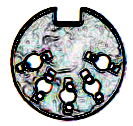The MIDI Protocol
The MIDI protocol was released in 1982 as a means for connecting electronic musical instruments. First synths to feature the new technology were the Prophet-600 and the Jupiter-6. Although limited in resolution from a recent point of view, it is still a standard for conventional applications - yet to be replaced by the newly released MIDI 2.0. Besides rare mismatches and some limitations, MIDI devices can be connected without complications. Physically, MIDI has been introduced with the still widespread 5-pin connector, shown below. In recent devices, MIDI is usually transmitted via USB.
Standard MIDI Messages
MIDI transmits binary coded messages with a speed of $31250\ \mathrm{kbit/s}$. Timing and latency are thus not a problem when working with MIDI. However, the resolution of control values can be a limiting factor. Standard MIDI messages consist of three Bytes, namely one status Byte (first bit green) and two data bytes (first bit red). The first bit declares the Byte either a status Byte (1) or a data Byte (0).

Standard MIDI message with three Bytes.
Some of the most common messages are listed in the table below. Since one bit is used as the status/data identifier, 7 bits are left for encoding. This results in the typical MIDI resolution of \(2^7 = 128\) values for pitch, velocity or control changes.
Voice Message Status Byte Data Byte1 Data Byte2 ------------- ----------- ----------------- ----------------- Note off 8x Key number Note Off velocity Note on 9x Key number Note on velocity Polyphonic Key Pressure Ax Key number Amount of pressure Control Change Bx Controller number Controller value Program Change Cx Program number None Channel Pressure Dx Pressure value None Pitch Bend Ex MSB LSB
Pitch Bend
If you are stuck with MIDI for some reason but need a higher resolution, the Pitch Bend parameter can help. Each MIDI channel has one Pitch Bend, each with two combined data Bytes, resulting in a resolution of \(128^2 = 16384\) steps.
System Exclusive
SysEx messages can be freely defined by manufacturers. They are often used for dumping or loading settings and presets, but can also be used for arbitrary control purposes. SysEx messages can have any length and are not standardized.
MIDI Note to Hertz
When working with MIDI, a conversion from MIDI pitch to Hertz is often necessary. There are two simple formulas for doing that. They both refer to the MIDI pitch of 69, wich corresponds to a frequency of 440 Hz:

